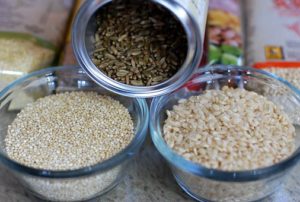 Top 10 Plant Foods for Eye Health
Top 10 Plant Foods for Eye Health
Guest post by Emily Pham
People often think that failing eyesight is an inevitable consequence of aging or eye strain. A healthy lifestyle can significantly decrease the risk of eye health problems. A diet rich in beta-carotene, Vitamins C and E, and omega-3 fatty acids will help to protect your eyes. Also, by adding these healthy foods to your diet, and cutting out unhealthy eating habits, you can maintain a healthy weight, helping to reduce the chance of developing obesity-related type II diabetes.
Read on for our list of 10 of the best foods to improve your eye health:
Nutrient-dense greens like turnip greens, kale, collard greens, and spinach should be top of the menu when it comes to protecting the eye. They all provide two vital nutrients – zeaxanthin and lutein – which have powerful antioxidant functions, helping prevent cell damage. A study has even indicated that consuming zeaxanthin and lutein can slow the progression of macular degeneration (AMD) if you are already affected by it.
Lutein acts like sunblock, protecting your eye’s retina from damaging natural light and kale is one of the most lutein-rich foods. These leafy greens also contain Beta Carotene (from which our bodies make Vitamin A). This is essential for good vision since it helps to protect the cornea (the surface of your eye).
Dark leafy greens are great when blended into smoothies or used as the base for a salad, but gently cooking the greens helps the body better absorb lutein. You can mix some into stews and soups or steam a couple of handfuls for a side dish. Additionally, since zeaxanthin and lutein are fat soluble, add a little coconut oil or olive oil to reap even more benefits.
Bright orange vegetables get the color from the natural orange pigment beta-carotene, which our body then converts into Vitamin A. The excellent point of meeting the Vitamin A needs through whole foods, instead of supplements, is that the body converts as much beta-carotene as it needs to. Hence you do not run the risk of overdosing on Vitamin A that can be toxic in excess.
Our mother wasn’t lying when she told us carrots would help us see in the dark – a deficiency of Vitamin A can cause worsening vision at night! Other foods that are rich in beta-carotene – that aid the body in forming and maintaining the collagen found in the cornea of the eye – include pumpkin, sweet potato, and squashes. According to the British Journal of Ophthalmology orange pepper had the highest amount of zeaxanthin of the 33 fruits and vegetables tested.
Try a roasted squash soup, snack on orange bell peppers with hummus, and switch to sweet potato fries that are much tastier and healthier than standard chips!
Tangerines, oranges, lemons, and grapefruits are all rich in Vitamin C which is vital to eye health. The antioxidants found in these fruits can delay or even prevent AMD and cataracts.
Vitamin C can be destroyed by light and heat, so it is best to enjoy these fruits freshly juiced or cut. Try a freshly made orange and carrot juice (double the goodness for the eyes!) or drizzle an olive oil and lemon juice dressing over a leafy green salad.
These fruits likewise have flavonoids – antioxidants which work with Vitamin C to prevent cancers and the impacts of aging, as well as protecting against macular degeneration and cataracts.
All berries – from strawberries to blueberries – are powerhouses of Vitamin C that decreases the risk of developing cataracts and macular degeneration. Of all the berries, blackcurrants have some of the highest levels of the antioxidant anthocyanins, with bilberries likewise boasting impressive amounts. Plus, red-colored berries also provide beta-carotene – another great eye-friendly nutrient.
There’s no limit to what you can do with in-season fresh berries – from juices or milkshakes to fruit salads and jams. Out of season, you can supplement with bilberry extract or some black currant seed oil.
As one of the most famous vegetables out there when it comes to nutrients, broccoli is a must-eat food if you’re concerned about eyesight. Not only does it have that fantastic duo – zeaxanthin and lutein, along with eye-boosting beta-carotene – but it’s extremely rich in Vitamin C, giving broccoli an excellent combination of nutrients for maintaining the eye health.
Add steamed broccoli to pasta dishes and salads, try roasting it in a little olive oil or sneak some into pesto.
The humble legume, from black-eyed peas to lentils, is a fantastic source of zinc and flavonoids. While critical for all-round immune health, zinc is also essential in enabling Vitamin A to travel from your liver to your eye where it is used to protect the retina. Additionally, a zinc deficiency can contribute to the symptoms of night blindness.
Add lentils to stews, curries, and soups. Snacking on homemade chickpea hummus and adding beans to salads are ways you can increase your zinc intake and keep the vision sharp.
In addition to providing Vitamins A and C, along with zeaxanthin and lutein, tomatoes offer a nutrient called lycopene that can contribute to good eye health. Lycopene in your eye tissue helps to prevent light-induced damage to your retina – as well as precluding free radical damage, which can cause certain eye diseases. Some studies have shown those with higher levels of lycopene get lower levels of ADM.
Cooking tomatoes makes the lycopene they provide easier for our body to assimilate, so try stuffing tomatoes with nutrient-rich vegetables before grilling or create your own pasta sauces.
Almonds, walnuts, pistachios and other nuts are high in Vitamin E and omega-3 fatty acids – both necessary for good eye health. A handful provides approximately half of the daily dose of Vitamin E. If possible, opt for pistachios, because they contain significant amounts of zeaxanthin and lutein. The fats in pistachios likewise help to boost the absorption of carotenoids.
Crumble nuts over salads, snack on a handful before lunch, or add to a vegetable stir-fry.
Not just for birds, seeds are a great addition to any diet when it comes to protecting the vision. Choose from sesame, pumpkin, sunflower, flax, hemp, or chia. Since each one has a unique nutritional profile, try to consume a variety of seeds so you get the benefits of Vitamin E, omega-3s, and zinc.
Seeds make great salad topper. They can easily be added to desserts and disguised in smoothies.
As a wonderful source of Vitamin E, the germ and bran of all whole grains can help fight age-related macular degeneration and cataracts while protecting our eyes from free-radical damage. Plus, these foods are a fantastic source of zinc and healthy fats – both imperative for overall eye health. Quinoa, brown rice, and teff have some of the highest levels of vitamin E. Rice bran is also an excellent source.
Enjoy in soups, salads, casseroles, with vegetables, or in baked goods.
More foods that are high in vitamin E.
Author Bio:
This guest post is by Emily Pham, a blogger with many years of experience in searching the best natural and effective remedies for health and beauty issues. All content provided is for informational and educational purposes. We recommend you consult a healthcare professional to determine which method is appropriate to you.

New Earth Ambassador — Sharing Health, Wealth & Faery Magic to Uplift Your Life and the World!
What I love best is holding space for people to tap into the New Earth reality — a reality of harmony, cooperation and prosperity for all. I call it the New Camelot! I spend most of my time creating courses, workshops, blogs and art to support citizens of the New Camelot in their ongoing quest for health, abundant wealth and the magic of the Otherworlds.
I am passionate about protecting Nature, a healthy whole-plant-foods diet, artistic creativity, graphic design, connecting seekers with the faery realm, Celtic and Arthurian lore, my family, writing and gardening.
All my services are all listed at WulfWorks.com (my portal site)










